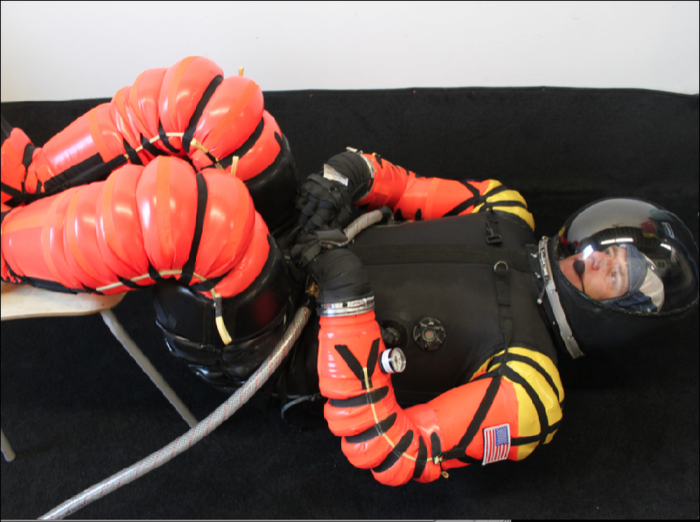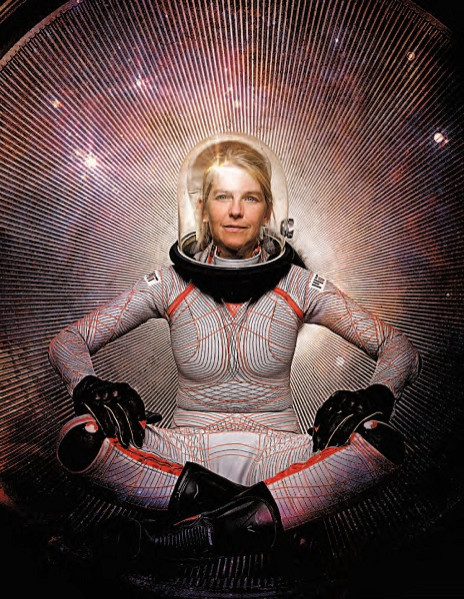Next Generation Spacesuits: From Brooklyn, MIT and NASA To Outer Space

When he’s not making 15-foot-high angel wings for Victoria’s Secret fashion shows or giant inflatable wolf heads for Cirque de Soleil, Ted Southern makes spacesuits.
Southern and his business partner, Russian spacesuit expert Nikolay Moissev, have set up shop in the Brooklyn Navy Yard, once a bustling port, now a complex populated with startups and art studios. From their relatively humble workspace, Southern and Moissev are turning out sleek new suits for commercial space industry clients and spacesuit components for NASA. Their company, Final Frontier Design, is just one player in a small but growing field aimed at producing the next generation of astronaut outerwear.
Going from making costumes for Heidi Klum to courting the likes of NASA and SpaceX isn't as unlikely as you might think.
“I’ve always dealt with structures, and thought about how to make them lightweight,” Southern says. “And I’ve always been interested in mechanical stuff.”
Moissev and Southern met a few years ago when they were taking part in a 2007 NASA competition to build a better astronaut glove. Moissev was a lead designer at Zvezda, the company that provided suits to the Russian space agency Roscosmos; Southern had experience in designing and engineering costumes, props, and all kinds of special effects. Neither took the top prize in the glove contest, but they ended up joining forces and scored a second-place win in another NASA glove competition in 2010. Their combination might seem a bit unorthodox, but the team’s designs have performed well enough to garner two NASA contracts and a successful Kickstarter campaign that raised more than $27,000.
Final Frontier is designing a spacesuit meant for the takeoff and landing portions of flight, similar to the bright orange Advanced Crew Escape Suit (ACES, though sometimes called the “pumpkin suit”) worn by space shuttle crews. Such suits are designed to provide a pressurized environment in the event of an emergency – like a hull breach – that causes the cabin of a spacecraft to depressurize. Basically, they’re full-body versions of the emergency oxygen masks that drop down in an airline emergency.
Without a pressurized spacesuit, malfunctions at takeoff or reentry can prove fatal, as they did for the cosmonauts of Soyuz-11. In 1971, Russian spacefarers Georgi Dobrovolski, Vladislav Volkov, and Viktor Patsayev died during the reentry of their capsule. An investigation revealed that an air vent in the craft opened up far too soon – 104 miles above the ground – and exposed the cosmonauts to vacuum. Without spacesuits, the loss of pressure inside the Soyuz capsule proved fatal in less than a minute.
But a pressurized spacesuit is also hard to move in. If you look at footage from the Apollo missions, you’ll see that Neil Armstrong, Buzz Aldrin and company move around on the moon mostly by bunny-hopping. The astronauts had to hop because they had trouble bending at the waist and knees in their stiff spacesuits.
“If you want to just make most basic pressure garment, you just need a gas-filled bag,” Raul Blanco, chief of the space suit and crew survival systems branch at the NASA Johnson Space Center, explained in a phone interview. “If you want mobility, you have to look at every single joint of your body and how it moves.”
Hands are the trickiest part of a spacesuit to make. Right now the gloves on the spacesuits worn on the International Space Station give astronauts about 20 percent of the grip strength they’d have with their bare hands on Earth; NASA’s currently trying to bump that up to 60 percent.
Final Frontier’s trick for making a suit that’s flexible under pressure is what Southern calls “creative patterning.” Their suits have small, strategically placed pockets that allow the joints to move, and maintain the same volume of air inside the joint as it flexes. They’re also focused on a single-layer design that is lighter and thinner than the double-layered ACES suit. Their design has already gone through two prototype models; Final Frontier aims to finish the third generation, or 3G design, by the end of this year.
Final Frontier’s NASA contracts aren’t for full spacesuits. One is for an elbow and shoulder assembly, and another for radiation protection coatings. Both contracts relate to spacesuits designed for “extra-vehicular activity,” which is anything that takes place outside a spacecraft, be it a spacewalk, or a stroll across the surface of Mars.
The company is also in talks with various private space companies. Final Frontier is sending one pressure suit to Spanish company Zero2Infinity, which plans to offer balloon rides up to 22 miles into the atmosphere – not quite outer space, but close enough for thrills.

Meanwhile, NASA is putting some of the finishing touches on the next model of its own next-generation spacesuit, the Z-2, which Blanco says the agency expects to have on hand about a year from now. The Z-1 suit, unveiled in December 2012, is suitable for use both on spacewalks and on planet surfaces. Another new feature of the Z-1 is that astronauts enter the suit through a rear hatch, making them easier to don and doff. Both the Z-1 and the Z-2 were built by ILC Dover, the Delaware-based engineering company that outfitted the Apollo astronauts and which made the EVA suits for both the Space Shuttle missions and the ISS.
Red Tape In Space
As with any business, there are frustrations. One Cold War relic that’s been a thorn in the side of Final Frontier – and pretty much the entire private space industry – is a set of U.S. regulations called the International Traffic in Arms Regulations, or ITAR. Basically, the military still considers spacesuits a piece of sensitive defense technology, so there’s much more red tape to wade through. ITAR has stymied some of Final Frontier’s attempts to work with Canadians and has racked up about $6,000 to $7,000 in legal fees in a year. While Boeing would probably barely blink at that figure, it’s a sizable enough chunk of change for a small outfit like Final Frontier.
ITAR has also caused some headaches in Final Frontier’s Kickstarter campaign. A German citizen who contributed at the highest levels of the fundraiser is entitled to his own custom spacesuit, but under ITAR, the company can’t ship it to him directly. The Spanish balloon company has offered to step in as a middleman for the transaction.
It’s a bit galling, Southern says, because “we’re building something that’s specifically not a military garment.”
Form And Function
It’s still unclear what features will come to define the next era of spacesuits. Jeff Feige, the CEO of Orbital Outfitters, a spacesuit company based in Washington, DC and California, compares the current state of the space industry to very early aviation.
“With early aircraft, it wasn’t clear what the ‘best’ plane was, whether it was a one-wing, two- or three-wing craft,” he said in a phone interview.

Other next-generation spacesuits depart even more radically from traditional designs. MIT professor Dava Newman is working on an updated version of a “mechanical counterpressure” suit that ditches the whole concept of the inflated balloon look for a design that’s more like a science-fiction speed skater. But Newman’s BioSuit still has a long way to go to move out of the lab and into the spacecraft.
Both Final Frontier and Orbital Outfitters have dealt with a particular private company whose contracts stipulate that suits should look “badass,” but aesthetic concerns (however phrased) often have to take a back seat to making sure the suit does its job of keeping an astronaut alive.
When assessing the artistic value of his own spacesuits, Southern is reminded of a modernist architectural creedo: form follows function.
“I see a great deal of beauty in that [functionality] on its own,” Southern says.
Still, companies want a bit of visual flair. And sometimes clients want spacesuit designs that are unattainable at present.
“The classic one is –“ Feige says, pausing to phrase his words delicately -- “people want suits they can put on women to make them look like women. And while we can sometimes create the appearance of hips, there’s only so far we can go.”
There are also much larger design issues at play. Feige thinks companies should incorporate spacesuit design in the earliest stages of spacecraft development. So much of the spacecraft’s design – cabin volume, seating configuration, how the life support system connects to the suit – makes a big impact on the spacesuit designer's work.
“Spacesuits are not just the clothing you wear at launch day,” Feige says. “They’re an integrated safety subsystem. They’re the point where the human touches the vehicle.”
© Copyright IBTimes 2025. All rights reserved.





















